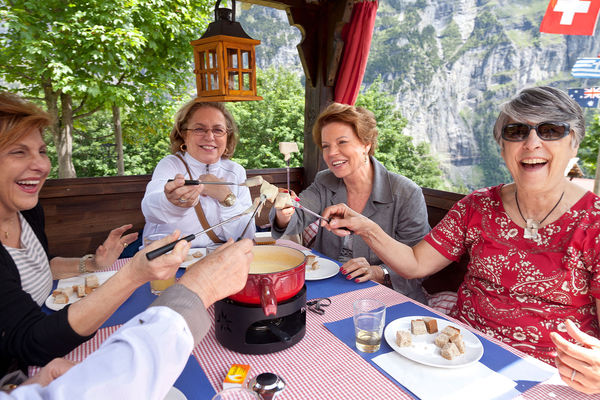What’s Cooking in Switzerland
By Fritz Hutmacher
During your stay in Switzerland, youll find that the local specialties vary according to the region. Whereas the French speakers favor Raclette, the German-speakers' specialty is Rösti. Of course, you can get whatever your heart desires, ranging from fast food to gourmet cuisine. Here are some flavors to seek out on your next visit to Switzerland:
Hobelkäse, a specialty in the Berner Oberland, is a mature (2–3 years old), very finely sliced mountain cheese. Hobelkäse is made at local alpine cheese dairies, and you can usually watch it being made between 9:00 and 10:00 in the morning — ask your hotel for details.
Fondue is a unique melted-cheese specialty familiar around the world. Its secret lies in the combination and maturity of the various cheeses used. One portion consists of 5 ounces of cheese and 1 deciliter (about 3.5 fluid ounces) of wine. Ready-made mixes are available, but a good restaurant will use its own cheese mixture. Most travelers find a whole portion of this high-calorie, high-fat meal too much, so try splitting two portions among four people. Some restaurants offer portions for just one person. Ask the locals for the best fondue restaurant — there are not many places where we would go out to eat fondue.
Raclette is another cheese-lover's favorite. Hold half a block of cheese over the fire until it melts and has a crispy edge, then scrape the melted cheese onto a pre-warmed plate with a knife. Serve with potatoes boiled in their skins, known as Gschwellti. Yum!
Rösti, a legendary dish from the Berner Oberland, is a must for visitors to the German-speaking part of Switzerland. It's not unlike American hash browns: crisply fried grated potato, turned over in one piece in the pan, like a pancake. It used to be fried in lard and butter and eaten for breakfast, but today's Rösti is served in many variations. The most popular variety is with bratwurst and onion gravy. If the sausage has been made from the local pigs kept on the Alps, you're really in luck. These pigs spend the summer running around the alpine pastures and are fattened with the milk left over from cheesemaking. Sausages made from the meat of these happy pigs are usually only found in small villages off the beaten track.
If you are around Zürich, try the legendary Züri Geschnetzeltes — slices of meat in a cream sauce. The original recipe uses one third of a calf's kidneys, so read the menu carefully and if you don't like kidneys, order without.
Also keep an eye out for seasonal specialties, including fresh river trout (Bachforelle) and local wild mushrooms (Steinpilze and Eierschwämme) from July until October. From September until November, local game (Wild) is in season. Again, you should ask the locals for the best place to go, as 80 percent of game is imported — only a few eateries, who put a lot of loving care into its preparation, buy it from the local hunters. These restaurant proprietors are often hunters themselves.
No matter where or what you eat in Switzerland, remember: Don't tip! A hefty service tax and sales tax are included in the price nationwide. Thanks to high protective duties, food is expensive enough in Switzerland — so save your tip money for a nice chunk of real Swiss chocolate.
Fritz Hutmacher was the longtime propreitor of Interlaken's Hotel Lötschberg.


